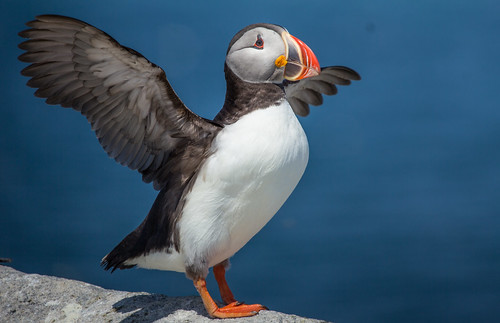 |
Most birds don’t live to be nearly as long as we humans—at least, not as far as we can tell. Based on the longevity records from the USGS Bird Banding Lab, we know that most of the birds that survive for three full decades or more are oceanic species—five species of albatrosses have reached the 30-year milestone, along with the Bonin Petrel, Ashy Storm-Petrel, and Red-tailed Tropicbird. One Great Frigatebird made it to 43.
A Western Gull made it to 33, a Sooty Tern made it to 35, a Royal Tern to 30, and one incredible long-distance migrating Arctic Tern lived to be 34 years old. That bird was caught at a banding station and its band replaced in 1970. If it were caught again, it would take some digging to trace it back to the original band number. The original band was left on a 33-year-old Atlantic Puffin that was caught alive and released.
Terrestrial birds and those associated with freshwater aren’t as long-lived as oceanic species, though several have made it at least 30 years. One Canada Goose lived to be 33. A Bald Eagle banded on the nest in Maine in 1977 survived for 32 years and 10 months before being killed by a car in New Brunswick. The oldest known Golden Eagle, from Utah, was also killed by a car—that one at 31 years of age. And a Michigan Red-tailed Hawk made it 30 years before being found dead, though the cause of its death wasn’t noted. One Sandhill Crane banded in Wyoming survived 36 years before being found dead in New Mexico—again, the cause of death wasn’t recorded. Despite being the most heavily hunted species in all of America, at least one banded Mourning Dove lived to be 30 years old before a hunter killed it and sent in its band.
Individuals of four different species of hummingbirds have lived at least 10 years—the Buff-bellied, Magnificent, Black-chinned, and Broad-tailed.
Not one songbird is listed on the USGS Bird Banding Laboratory longevity website as having survived 30 years; indeed, individuals of only two species of songbirds are known to have lived into their twenties. A Chihuahuan Raven was caught alive when 21 years 9 months old, and released with the same band. And at least three Common Grackles have made it to 20. The oldest was killed by a car when it was 23.
A few species of jays and an American Crow have lived over 15 years. More surprising is the Gray Catbird that was caught alive when it was 17 years 11 months old—that one was released with the same band. One cardinal lived over 15 years, and an Evening Grosbeak banded in Connecticut in 1959 was killed by a car in New Brunswick when it was 16.
Individuals of 10 North American warbler species have lived over 10 years—at least one Yellow Warbler, Ovenbird, and Louisiana Waterthrush were caught at banding stations when they were at least 11 years old, all alive and released. One Black-and-white Warbler was found dead when it was 11.
Finally, the oldest known wild chickadee, from Minnesota, was at least 11 years 6 months when it was caught alive and released in 2011. Chickadees have to pack a lot of living into those 11 years—I feel darned lucky to have been given 63 and counting. Luckily enough for me, no one’s trapped me in a net and stuck a metal ring around my leg. Let’s hope my luck holds out.